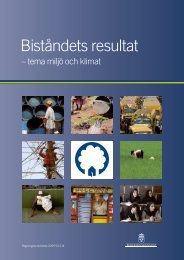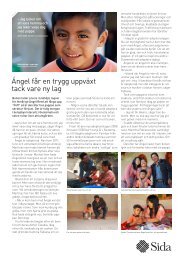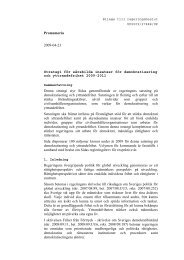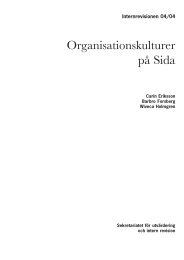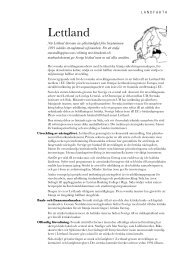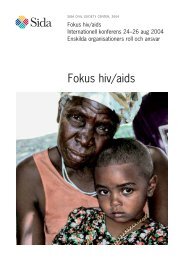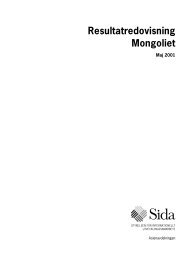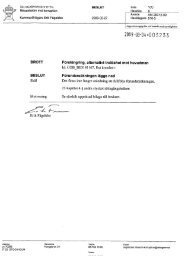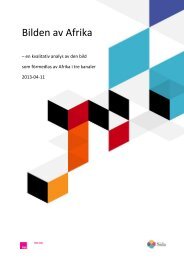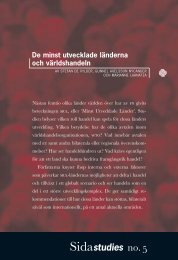Mobilisation of the Poor – a means to Poverty Reduction? - Sida
Mobilisation of the Poor – a means to Poverty Reduction? - Sida
Mobilisation of the Poor – a means to Poverty Reduction? - Sida
You also want an ePaper? Increase the reach of your titles
YUMPU automatically turns print PDFs into web optimized ePapers that Google loves.
Key strengths <strong>of</strong> CAP<br />
The sustainability <strong>of</strong> CAP until now can be attributed <strong>to</strong> <strong>the</strong> following fac<strong>to</strong>rs:<br />
1. Unlike many o<strong>the</strong>r state-initiated development or poverty alleviation programmes, CAP has<br />
not been guided by, or identified with, party politics, with <strong>the</strong> result that <strong>the</strong> programme<br />
remained more or less unaffected by increasingly turbulent political shifts at national elections.<br />
Thus, while many <strong>of</strong> <strong>the</strong> high-pr<strong>of</strong>ile national poverty alleviation programmes came <strong>to</strong> an end<br />
when governments changed, CAP was not disrupted by new governments wanting <strong>to</strong> start with<br />
clean slates.<br />
2. The programme has demonstrated considerable adaptability, having survived <strong>the</strong> shift in policy<br />
environment from central planning <strong>to</strong> economic liberalisation. This policy shift resulted in an<br />
important but largely unrecognised reorientation <strong>of</strong> <strong>the</strong> mobilisation strategy, from a<br />
production relations/conflict approach where <strong>the</strong> organised poor were expected <strong>to</strong> collectively<br />
bargain with <strong>the</strong> exploitative middlemen, <strong>to</strong> one where <strong>the</strong> poor <strong>the</strong>mselves aim <strong>to</strong> become<br />
micro-entrepreneurs using credit and o<strong>the</strong>r locally available services. With this shift CAP has<br />
been able <strong>to</strong> enter <strong>the</strong> era <strong>of</strong> liberalisation and overcome any possible contradiction that <strong>the</strong><br />
original conscientisation approach had with <strong>the</strong> increasingly dominant neo-liberal framework.<br />
3. CAP small groups, which constitute <strong>the</strong> base or foundation <strong>of</strong> CAP, have shown a remarkable<br />
resilience, contracting <strong>the</strong>ir operations when conditions are unfavourable and bouncing back<br />
in<strong>to</strong> activity once <strong>the</strong> situation improves.<br />
4. The gradual evolution <strong>of</strong> <strong>the</strong> programme <strong>to</strong> one with mainly women at <strong>the</strong> base has also<br />
contributed <strong>to</strong> its resilience and adaptability. In addition <strong>to</strong> <strong>the</strong> purely economic functions and<br />
contributions <strong>to</strong> livelihoods in vulnerable households, <strong>the</strong> small groups have provided much<br />
sought after social spaces within which women can interact with each o<strong>the</strong>r and pursue<br />
women-specific interests, including savings. While CAP has not led <strong>to</strong> a radical re-demarcation<br />
<strong>of</strong> gender roles, it has enhanced opportunities for women <strong>to</strong> expand <strong>the</strong>ir range <strong>of</strong> activities and<br />
social capital.<br />
5. CAP-related activities, including credit facilities, mutual help, and improved access <strong>to</strong> services,<br />
have added <strong>to</strong> <strong>the</strong> survival strategies <strong>of</strong> <strong>the</strong> rural poor. While such survival strategies do not<br />
necessarily help <strong>the</strong> poor <strong>to</strong> escape poverty as pointed out by Lakshman (1994), <strong>the</strong>y can be<br />
seen as one <strong>of</strong> <strong>the</strong> safety nets that help <strong>the</strong> poor <strong>to</strong> keep going at times <strong>of</strong> crisis and <strong>to</strong> overcome<br />
<strong>the</strong> vulnerabilities <strong>the</strong>y face due <strong>to</strong> environmental, socio-economic, and political constraints.<br />
The increased participation <strong>of</strong> women in <strong>the</strong> programme is particularly relevant, in that women<br />
are <strong>of</strong>ten more vulnerable <strong>to</strong> illness, abuses, and oppressions <strong>of</strong> various kinds.<br />
These fac<strong>to</strong>rs are <strong>the</strong> positive lessons <strong>to</strong> be learnt from CAP. Even though a relatively small-scale<br />
government programme, with regard <strong>to</strong> social mobilisation CAP has been a pioneer for various<br />
government and non-government programmes. As a result, social mobilisation, has come <strong>to</strong> be<br />
recognised as a necessary component in most programmes that target <strong>the</strong> rural poor.<br />
Key limitations <strong>of</strong> CAP<br />
This evaluation also discovered certain key weaknesses that pose serious problems for <strong>the</strong> future <strong>of</strong><br />
CAP.<br />
42<br />
MOBILISATION OF THE POOR <strong>–</strong> A MEANS TO POVERTY REDUCTION <strong>–</strong> <strong>Sida</strong> EVALUATION 02/08




